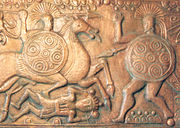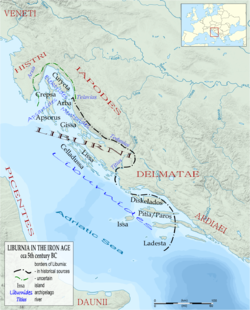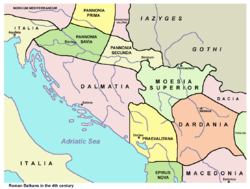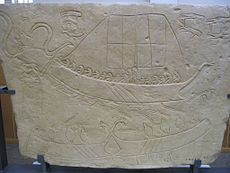- Liburnians
-
The Liburnians (or Liburni, Greek: Λιβυρνοί)[1] were an ancient Illyrian tribe inhabiting the district called Liburnia, a coastal region of the northeastern Adriatic between the rivers Arsia (Raša) and Titius (Krka) in what is now Croatia.
Liburnia in ancient geography was the land of the Liburnians, a region along the northeastern Adriatic coast in Europe, modern Croatia.
Contents
History
Classic age
The first account of the Liburni comes from Periplus or Coastal passage, an ancient Greek text of the mid 4th century BC.[2]
Fall of Liburnian domination in the Adriatic Sea and their final retreat to their ethnic region (Liburnia) were caused by military and political activities of Dionysius the Elder of Syracuse (406 – 367 BC). The imperial power base of this Syracusan tyrant stemmed from a huge naval fleet of 300 tetreras and penteras. When he finished Carthaginian authority and diminished concurrence in Sicily, Dionysius the Elder of Syracuse turned against the Etruscans. He made use of the Celtic invasion of Italy and the Celts became his allies in the Italian peninsula (386 - 385 BC). This alliance was crucial for his politics, then focused to the Adriatic Sea, where the Liburnians still dominated. In light of this strategy, he established a few Syracusan colonies on the coasts of the Adriatic Sea, Adria at the mouth of Po river and Ancona at the western Adriatic coast, Issa on the most outer island of the central Adriatic archipelago (island of Vis) and the others, while in 385-384 BC he helped colonizers from the Greek island of Paros to establish Pharos (Starigrad) colony on the Liburnian island of Hvar, thus taking control of the important points and navigable routes in the southern, central and northern Adriatic Sea.
This certainly caused simultaneous Liburnian resistance on the both coasts, in their ethnic domain and on the western coast where their possessions or interests were in danger. A great naval battle was recorded a year after the establishment of Pharos colony, by a Greek inscription in Pharos (384 – 383 BC) and by Greek historian Diodorus Siculus (80 – 29 BC), initiated by conflicts between The Greek colonizers and the indigenous islanders of Hvar island, who asked their compatriots for a support. 10,000 Liburnians sailed out from their capital Idassa (Zadar) led by Iadasinoi (people of Zadar) and laid a siege of Pharos. The Syracusan fleet positioned in Issa was informed in time and Greek triremes attacked the siege fleet, taking victory at the end. According to Diodorus, The Greeks killed more than 5,000 and captured 2,000 prisoners, ran down or captured their ships and burnt down their weapons in dedication their god.
This battle meant the loss of the most important strategic Liburnian positions in the centre of the Adriatic Sea, resulting in their final retreat to their main ethnic region, Liburnia, and their complete departure from the Italic coast, except from Truentum. Greek colonization, however, did not penetrate into the Liburnian area, which remained strongly held, while Syracusan dominance suddenly diminished, very soon, after death of Dionysius the Elder of Syracuse. The Liburnians recovered and developed piracy to secure navigable routes in the Adriatic, as recorded by Livius in year 302 BC.[3]
The middle of the 3rd century BC was marked by the rise of an Illyrian kingdom in the south of the Adriatic Sea, led by king Agron of the Ardiaei. Its piratical activities imperiled Greek and Roman interests in the Adriatic Sea and caused the first Roman intervention at the eastern coast in 229 BC; Florus (II,5) noted the Liburnians as the Roman enemies in this expedition, while Appian (Bell. Civ., II, 39) noted liburnae as swift galleys the Romans first fought with when they entered to the Adriatic Sea. Obviously, they were the allies of their southern Illyrian compatriots, Ardiaei and the others, but in a lack of more records from the 3rd century BC, related to them, it is supposed that they mostly stayed aside, in the following Roman wars and conflicts with Pyrrhus, Carthage, Macedonia and southern Illyrian state,[4] However, although their territory was not involved in these confrontations, it seems that the Liburna warship was used by the Romans during the Punic Wars[5] and in the Second Macedonian War.[6]
Hellenistic and Roman periods
In 181 BC, the Romans established their colony in Aquileia and took control of all Venetia in the north, thus expanding towards the Illyrian area from the north-west. In 177 BC they conquered Istria in the north of the eastern Adriatic coast, settled by tribe of Histri, while the Iapodes, the northern Liburnian neighbors, attacked Aquileia in 171 BC, but these accidents did not involve the Liburnian territory. The Liburnians probably kept away from direct conflicts with the Romans to safeguard their remaining naval activities. After their arrival to the west of Liburnia, the Roman legions also appeared on its southern borders, defeating the southern Illyrians and finally king Gentius in 167 BC and during wars against tribe of Dalmatae in 156 BC – 155 BC. First Roman appearance in the Liburnian seas happened in 129 BC, during the military expedition of the Roman consule Gaius Sempronius Tuditanus against the Iapodes, which ended with hardly won victories over Iapodes, Carni, Taurisci and Liburnians.
In 84 BC, the Roman consuls, enemies of Sulla, mobilized an army in Italy and tried to use Liburnia, probably some outer island, to organize military campaign back to Italy, against Sulla, which failed due to bad weather conditions and low morale of the soldiers, who massively escaped to their homes in Italy or refused to cross over the sea to Liburnia. The Roman legions once again passed through the Liburnian territory, probably by sea along the coast, in their next expedition against Dalmatae in 78 – 76 BC, started from the north, from Aquilea and Istria, to stabilize control of Dalmatian city Salona.[7]
In 59 BC Illyricum was assigned as a provincia (zone of responsibility) to Julius Caesar and Liburnian Iadera was nominally proclaimed a Roman municipium, but real establishment of the Roman province occurred not earlier than in 33 BC. Dalmatae soon recovered and stepped into conflict with the Liburnians in 51 BC, probably because of possession of the pasture grounds around Krka river, taking their city Promona. The Liburnians were not strong enough to reconquer it, so they voluntarily subjected to the Romans asking help from Caesar, actual Roman proconsul of Illyricum, but Liburnian army strategically supported by the Romans was heavily defeated by Dalmatae.[8]
Civil war between Caesar and Pompey in 49 BC affected all of the Roman Empire as well as Liburnia. In the same year, near island of Krk, there was an important naval battle between armies of Caesar and Pompey, probably due to the local Liburnian support to one or another side. Caesar was supported by the urban Liburnian centres, like Iader, Aenona and Curicum, while the rest of Liburnians supported Pompey, including city of Issa which citizens were in conflicts with Caesar supporting Dalmatae from Salona. "Navy of Iader" (Zadar) probably equipped by mixed Liburnian and Roman ships confronted "Liburnian navy" in service to Pompey, equipped only with Liburnians in their liburna galleys. Thus Liburnian naval force was dragged into the Roman civil war, partially by force, partially because of local interests of the participants. Caesar rewarded his supporters in Liburnian Iader and Dalmatian Salona, by giving status of the Roman colonies to their communities, but battle was won by the Liburnian navy, which prolonged the civil war and ensured control of the Adriatic Sea to side aligned with Pompey in next 2 years, until his final defeat in 48 BC. In the same year, Caesar sent his legions to take control of rebelled Illyricum province, and took the fortress of Promona from Dalmatian hands, making them submit.[9]
In all that period the Roman rule in only nominally established Illyricum province was concentrated only to a few cities at the eastern Adriatic coast, such as Iader, Salona and Narona. Renewed Illyrian and Liburnian pirate activities motivated Octavian to organize great military operation in Illyricum province in 35 BC, to finally stabilize Roman control of it. Action was first concentrated on the coastal Illyrian tribes to the east of Narona, then it prolonged to the depth of the Illyrian territory, where continental tribes gave much stronger resistance. After return from inland of Illyricum, Octavian destroyed Illyrian pirate communities in the islands of Melita (Mljet) and Korkyra Nigra (Korčula) and continued to Liburnia, where he wiped out the last remains of the Liburnian naval forces, resolving problems of their renewed piratical activities in the bay of Kvarner (sinus Flanaticus) and attempt to secede from Rome. Octavian commandeered all the Liburnian ships. Very soon these galleys would play a decisive role in the battle near Actium.
Octavian went for another expedition to the inland, against the Iapodes, from the Liburnian port of Senia (Senj) and conquered their most important positions in 34 BC. In the next 2 years the Roman army, led by Marcus Vipsanius Agrippa fought hard battles with the Dalmatae. Liburnians were not recorded as participants in this war but their most southern territories were surely involved.[10]
It is not certain whether Liburnians joined the last Great Illyrian Revolt, this remains controversial, as the only evidence is a damaged inscription found in Verona, mentioning Iapodes and Liburnians under an unknown leader.[11]
Throughout the centuries, naval power was the most important aspect of warfare for the Liburni. When the empowered Roman forces defeated the Liburni, the region became a part of the Roman province of Dalmatia, but marginal in a military sense. Burnum on Krka river became a Roman military camp, while frequently settled and already urbanized plains of Classical Liburnia, in the inland of Iader, became easily accessible and controlled by Roman rulers. However the Liburnian sea-faring tradition was never wiped out, gaining mainly a commercial character under these new circumstances. It contributed to the economical and cultural thriving of its ports and cities, as well as of those in all the province. Despite Romanization, especially in larger cities, Liburnians retained their traditions, cults, burial customs (Liburnian cipus), names etc., as attested by the archaeological evidence from those ages.[12]
Archaeology
Further information: Prehistoric BalkansDevelopment of Liburnian culture can be divided in 3 main time periods:
- 11th and 10th century BC. Between two waves of Balkan-Pannonian migrations; it was transitive period between the Bronze Age and the Iron Age, which features were more related to the Late Bronze Age. It was characteristical for influence of the Urnfield Culture which was spread in the Pannonian areas and in addition for global changes caused by Balkan-Pannonian migrations.
- 9th to the 5th century BC. Liburnian domination in the Adriatic Sea; its first phase (9th century BC), because of mentioned migrations, did not continue development of the Late Bronze Age, but certain forms only. It was beginning of the Liburnian Iron Age marked by their expansion and colonization of Picenum, Daunia and Apulia at the Italic shores, which resulted in rich and high level of their cultural development in the 8th and 7th century BC, based on sea trade and followed by isolation from the Balkan area, except from Iapodia. Rich material exchange with the other Adriatic coasts was continued in the 6th century BC and connection to Picenum was still strong, but also links to Iapodes and Dalmatae has been attested. However, in the 5th century BC, the Greeks undertook leadership of trade in the Adriatic Sea and considerable changes occurred, like widening of the import of Greek products.
- 5th to the 1st century BC. Decline of their power; Liburnian culture changed thoroughly under Hellenistic influence, although local specifics were retained. Except extended import of Hellenistic and Italic pottery and other lesser influences, Liburnian cultural relations with other peoples were rather poor.
Settlements
Main article: List of ancient cities in IllyriaThe principal forms of settlements were forts (Latin: castellum, Croatian: gradina) for defence, usually built on elevations and fortified with dry walls. In the Liburnian territory, about 400 have been identified so far, but they were considerably more numerous. About a hundred of names of these hill-forts have kept their roots from prehistory, especially places that had been inhabited permanently, such as Zadar (Iader), Nin (Aenona), Nadin (Nedinium), Rab (Arba), Krk (Curicum) etc. The dwellings were square dry-wall ground-floor buildings of one room. Similar stone houses are saved in Croatian tradition in all Dalmatia and Kvarner, mostly of rounded form, called bunja.
Burial tradition
The Liburnians buried their dead in graves near or beneath settlements. They laid their dead on a side in contracted position, mostly in chests of stone slabs. Tumuli are numerous on all Liburnian territory and especially in the narrowest region of Classical Liburnia (Nin, Zaton, etc.). Although the most of graves were used from the beginning of the Iron Age, many were continually used from the Copper Age or from the Early Bronze Age to the end of the Iron Age. Inhumation under tumuli in the Liburnian territory was undoubtedly inherited from the earlier times.
Material culture
The movable remains of culture are represented by various artifacts, mostly jewellery, pottery and parts of costume. Other forms are not so common, such as weapons, tools etc. Especially numerous are fibulae, some twenty forms and many more variants, as well as ornamental pins. Small sculpture is fairly frequent, representing animals and people. From the Liburnian territory, various coins from 23 mints are known, from 6th and mostly from 3rd century, from Greek cities, colonies, Italian cities, Illyrian rulers, North African, Celtic and Roman. Bronze and glass vessels occur very rarely. Pottery originated mostly from settlements and from tumuli, but it rarely occurs in tombs, except in rare tombs of Hellenistic type. Pottery was made without throwing, with a mixture of calcite, and burnt on an open fire. Imported pottery is also frequent, especially from southern Italy, from 8th to 1st century BC, mostly Apulian vessels, but also some Greek pottery was imported.
Religion
Main article: Paleo-Balkanic religionThe mythology of the people of Illyria is only known through mention of Illyrian deities on Roman Empire period monuments, some with interpretatio Romana.[13] There appears to be no single most prominent Illyrian god and there would have been much variation between individual Illyrian tribes. The Illyrians did not develop a uniform cosmology on which to center their religious practices.[14]
Economy
Economy is manifested in traces of agriculture, stock breeding, crafts, trade, barter, seamanship (see section "Seafarers"), fishing, hunting, food collecting. The Liburnians traded over the whole Adriatic, Middle and East Mediterranean and northwestern Balkan peninsula. Mostly they exported to the territories of the Iapodes and Dalmatae, and across the Adriatic to Picenum and southern Italy, especially jewellery, cheese, clothing, etc., and they imported mostly from Italy, primarily pottery, and took over various coins. Importation of amber from the Baltic cannot be proven, but probably acquisition in the Liburnian territory. Individual features of particular cultures are conditioned by special forms of production and economy.
Social relations
Insights into social relations are possible by remains of culture, inscriptions from the Roman times, and the works of several authors. Traces of the special role women and their position in Liburnian society can be noted in their writings. They mention the original division into several tribes and territorial communities, later fused into a union of tribes and into a single ethnic community of the Liburnians, although the basic forms of social relations were the family and clan. Collections of tumuli corresponds to this, the number of graves in a tumulus (up to 18) through several generations, or individual interments, with up to 8 bodies at the most in each grave. Certain data suggest social division, stratification, and inequality, where the Liburnian aristocracy also kept many privileges, special status, and features of their culture under Roman rule.
Relations to other cultures
Liburnian culture in general developed and was formed mostly on the basis of inheritance and independent development, partly by transformation and adoption of foreign influence, particularly Italic and Hellenistic, and also by exchange, enrichment partly with imports of foreign goods. Links with the Pannonian basin were not so numerous as in Late Bronze Age. Much more important were links with the Iapodes, and especially with Dalmatae. The Histrian culture developed differently, and the links with the Liburnians were not so universal. Exchange with Italy was varied and important. The Liburnians had most versatile relations with Picenum because of Liburnian immigration, but also because of easiest links, and with southern Italy. Exchange with the Greeks was not ample, except in the Hellenistic age. Just like in other parts of the Mediterranean, large quantities of North African coins are prominent. Celtic influence is important, especially in jewellery and tools, but mostly it is not direct.[15]
Seafarers
The Liburnians were renowned seafarers, notorious for their raids in the Adriatic Sea, which they conducted in their swift galleys. The Romans knew them principally as a people addicted to piracy. The major harbour of Liburnian navy since 5th century BC was Corynthia at eastern cape of Krk island, including 7 unearthed docks, marine arsenal, and stony fortifications; this early harbour persisted in ancient and medieval function to 16th century.
Liburnians constructed different ship types; their galaia was an early prototype of transport galleys, lembus was a fishing ship[16][17][18] continued by the actual Croatian levut, and a drakoforos was apparently mounted with a dragonhead at the prow.[citation needed]
Remains of a 10 meters long ship from the 1st century BC, were found in Zaton near Nin (Aenona in Classical Liburnia), a ship keel with bottom planking made of 6 rows of the wooden boards on each side, specifically joined together, sewn with resin cords and wooden wedges, testifying the Liburnian shipbuilding tradition style, therefore named "Serilia Liburnica". Deciduous trees (oak and beech) were used, while some climber was used for the cords.[19] A 10th century AD ship of identical form and size, made with wooden fittings instead of sewn planking joints, was found in the same place, "Condura Croatica" used by the Medieval Croats. Condura could be the closest known vessel to the original "liburna" galley (see below) in form, only of much smaller size, with the same features of a quick and agile galley having shallow bottom, very straightened but long, with one large Latin sail and one row of oaks on each side.
Liburna
Main article: LiburnaThe most known Liburnian ship was their warship, known as a libyrnis (λιβύρνις, λιβυρνίς) to the Greeks and a liburna to the Romans, propelled by oars.
According to some thoughts, liburna was shown in the scene of naval battle, curved on a stone tablet (Stele di Novilara) found near Antique Pisaurum (Pesaro), outlined to 5th or 6th century BC, the most possibly showing imaginary battle between Liburnian and Picenian fleets. Liburna was presented as light type of the ship with one row of oars, one mast, one sail and prow twisted outwards. Under the prow there was a rostrum made for striking the enemy ships under the sea.
By its original form, the liburna was the most similar to the Greek penteconter. It had one bench with 25 oars on each side, while in the late ages of the Roman Republic, it became a smaller version of a trireme, but with two banks of oars (a bireme), faster, lighter, and more agile than biremes and triremes. The liburnian design was adopted by the Romans and became a key part of Ancient Rome's navy, most possibly by mediation of Macedonian navy in the 2nd half of the 1st century BC. Liburna ships played a key role in naval battle of Actium in Greece, which lasted from August 31 to September 2 of 31 BC. Because of the its naval and maneuver features and bravery of its Liburnian crews, these ships completely defeated much bigger and heavier eastern ships, quadriremes and penterames. Liburna was different to the battle triremes, quadriremes and quinqueremes not because of rowing but rather because of its specific constructional features.[20][21] It was 109 ft (33 m) long and 16 ft (5 m) wide with a 3 ft (0.91 m) draft. Two rows of oarsmen pulled 18 oars per side. The ship could make up to 14 knots under sail and more than 7 under oars.[22] Such a vessel, used as a merchantman, might take on a passenger, as Lycinus relates in the 2nd-century dialogue, traditionally attributed to Lucian of Samosata: "I had a speedy vessel readied, the kind of bireme used above all by the Liburnians of the Ionian Gulf."
 Bireme Roman warships, probably liburnians, of the Danube fleet during Trajan's Dacian Wars.
Bireme Roman warships, probably liburnians, of the Danube fleet during Trajan's Dacian Wars.
Once the Romans had adopted the liburnian, they proceeded to make a few adaptations to improve the ships’ use within the navy. The benefits gained from the addition of rams and protection from missiles more than made-up for the slight loss of speed.[23] Besides the construction, the ships required that the regular Roman military unit be simplified in order to function more smoothly. Each ship operated as an individual entity, so the more complicated organization normally used was not necessary.[24] Within the navy, there were probably liburnian of several varying sizes, all put to specific tasks such as scouting and patrolling Roman waters against piracy.[25] The Romans made use of the liburnian particularly within the provinces of the empire, where the ships formed the bulk of the fleets,[26][27][28] while it was included by small numbers in fleets of Ravenna and Micenum, where a large number of the Illyrians were serving, especially Dalmatae, Liburnians and Pannonians.
Gradually liburna became general name for the different types of the Roman ships, attached also to the cargo ships in the Late Antique. Tacitus and Suetonius were using it as a synonym for the battle ship. In inscriptions it was mentioned as the last in class of the battle ships: hexeres, penteres, quadrieres, trieres, liburna.[clarification needed][29]
In the Medieval sources the "liburna" ships were often recorded in use by the Medieval Croatian and Dalmatian pirates and sailors, but probably not always referring to the ships of the same form.
Language
Main article: Liburnian languageThe Liburnian language is an extinct language which was spoken by the ancient Liburnians, who occupied Liburnia in classical times. The Liburnian language is reckoned as an Indo-European language, in the Centum group. By different specualations, it appears to have been separate Indo-European language or on the same Indo-European branch as the Venetic language.
Extinction of the language and ethnicity
In AD 634 Heraclius invited[citation needed] the Chrovates or Chrobati (ancestors of the Croats), who lived on the north side of the Carpathians, in what is now southern Poland (or Galicia), to occupy the province as vassals of the Empire.[30] Their presence had a permanent effect on the Romanized culture, and the Liburnians faded[citation needed] as a distinct ethne.
See also
Sources
- Spanish Wiki article on the Roman Fleet
- HELVII u Jaderu i Liburniji, ["Helvii in Iader and Liburnia"], Radovi - zavoda za povijesne znanosti HAZU u Zadru, 37, Zadar, 1955, 9-37.
- Liburnski cipus iz Verone (CIL 5, 2200, 8852; CIL 3, 2190), ["Liburnian cippus from Verona"], Diadora, 10, Zadar, 1988, 73-99.
- "Prilog klasifikaciji liburnskih nadgrobnih spomenika, tzv. liburnskih cipusa - sjeverna grupa nalaza," [“Contribution to classification of Liburnian gravestones, so called cipuses - northern group of findings”], Izdanja HAD-a, 13, Arheoloska istrazivanja na otocima Krku, Rabu i u Hrvatskom primorju, Zagreb, 1989, 51-59.
- "Aserijatska skupina liburnskih nadgrobnih spomenika, tzv. liburnskih cipusa," [“Asseriate group of Liburnian gravestones, so called cippi”], Diadora, 12: 209-299, Zadar, 1990; Diadora, 13, Zadar, 1991, 169-211.
- Ivo Fadić, Archaeological museum in Zadar
- Barac, L. et al., '"Y-chromosomal heritage of Croatian population and its island isolates", European Journal of Human Genetics, 11: 535-542, 2003.
- Batovic, Sime, Sepultures de la peuplade illyrienne des Liburnes, Bonn, 1962.
- Batovic, Sime, '"Die Eisenzeit auf dem Gebiet des illyrischen Stammes der Liburnen." Archaeologia Jugoslavica '6 (1965.), 55 p.,
- Tolk, H.V. et al., "MtDNA haplogroups in the populations of Croatian Adriatic Islands." Coll. Anthropologica 24: 267-279, 2000.
- Wilkes, John J., The Illyrians, Blackwell Books, 1992.
- Yoshamya, Mitjel and Zyelimer Yoshamya, Gan-Veyan: Neo-Liburnic glossary, grammar, culture, genom, Old-Croatian Archidioms, Monograph I, pp. 1–1.224, Scientific Society for Ethnogenesis studies, Zagreb 2005.
- Brusic, Zdenko, Hellenistic and Roman Relief Pottery in Liburnia ISBN 1-84171-030-X. British Archaeological Reports (December 8, 1999), 254 pages, 122 plates of drawings and photographs.
Notes
- ^ Scyl. 21; Strabo vi. p. 407, vii. p. 484; Appian, Ill. 12; Stephanus Byzantinus; Scholia ad Nicander 607 ; Pomponius Mela, ii. § 49-50; Pliny's Natural History iii. 23; Florus ii. 5.
- ^ The Illyrians (The Peoples of Europe) by John Wilkes,1996,page 94
- ^ M. Zaninović, Liburnia Militaris, Opusc. Archeol. 13, 43-67 (1988), UDK 904.930.2(497.13)>>65<<, pages 49 -53
- ^ M. Zaninović, Liburnia Militaris, Opusc. Archeol. 13, 43-67 (1988), UDK 904.930.2(497.13)>>65<<, pages 45, 53
- ^ The Illyrians (The Peoples of Europe) by John Wilkes,1996,page 187,"the Liburna, with its low freeboard had already been adopted by the Romans during the wars against Carthage"
- ^ Livy xlii. 48
- ^ M. Zaninović, Liburnia Militaris, Opusc. Archeol. 13, 43-67 (1988), UDK 904.930.2(497.13)>>65<<, pages 53-55
- ^ M. Zaninović, Liburnia Militaris, Opusc. Archeol. 13, 43-67 (1988), UDK 904.930.2(497.13)>>65<<, pages 55, 56
- ^ The provinces of the Roman Empire: from Caesar to Diocletian, Tome 1, by Theodor Mommsen, William Purdie Dickson, Francis Haverfield,2004,ISBN-1593330251page 10,"the Dalmatians, who had for a number of years been in arms against the Romans, were forced to submit after the fall of their fortress Promona"
- ^ M. Zaninović, Liburnia Militaris, Opusc. Archeol. 13, 43-67 (1988), UDK 904.930.2(497.13)>>65<<, pages 57, 58
- ^ M. Zaninović, Liburnia Militaris, Opusc. Archeol. 13, 43-67 (1988), UDK 904.930.2(497.13)>>65<<, page 59
- ^ M. Zaninović, Liburnia Militaris, Opusc. Archeol. 13, 43-67 (1988), UDK 904.930.2(497.13)>>65<<, pages 59, 60
- ^ Wilkes, J.J. The Illyrians, 1992, p. 245, ISBN 0-631-19807-5. "...Illyrian deities are named on monuments of the Roman era, some in equation with gods of the classical pantheon (see figure 34)."
- ^ Wilkes. "Unlike Celts, Dacians, Thracians or Scythians, there is no indication that Illyrians developed a uniform cosmology on which their religious practice was centred. An etymology of the Illyrian name linked with serpent would, if it is true, fit with the many representations of..."
- ^ Š. Batović, Liburnska kultura, Matica Hrvatska i Arheološki muzej Zadar, Zadar, 2005, UDK: 904 (398 Liburnija), ISBN 953-6419-50-5
- ^ Hans Krahe, Die Sprache der Illyrier, I. Teil, Wiesbaden, 1955, p. 114.
- ^ H. Krahe, Griech. λέμβος, lat. lembus - eine illyrische Schiffsbezeichnung?, Gymnasium, 59/1952, H. 1, p. 79.
- ^ L. Casson, Ships and Seamanship in the Ancient World, Princeton, 1971, pp. 141-142.
- ^ Z. Brusić, Istraživanje antičke luke kod Nina, Diadora 4, 1968, pages 206-209
- ^ C.G. Starr Jr., The Roman Imperial Navy 31 B.C. – A.D. 324, West-port, Connecticut 1975, page 54
- ^ M. Zaninović, Liburnia Militaris, Opusc. Archeol. 13, 43-67 (1988), UDK 904.930.2(497.13)>>65<<, pages 46, 47
- ^ Gabriel, Richard A.. "Masters of the Mediterranean". Military History (December 2007).
- ^ Morrison, J. S., and J. F. Coates. 1996. Greek and Roman Warships 399-30 B.C. Oxford.pgs 170, 317.
- ^ C. G. Starr, The Roman Imperial Navy 31 BC-AD 324, 3rd ed., Chicago, 1993, p. 59.
- ^ J. S. Morrison and J. F. Coates, Greek and Roman Warships 399-30 B.C., Oxford, 1996, p. 317.
- ^ L. Casson, Ships and Seamanship in the Ancient World, Princeton, 1971, p. 141.
- ^ C. G. Starr, The Roman Imperial Navy 31 BC-AD 324, 3rd ed., Chicago, 1993, p. 54.
- ^ J. S. Morrison and J. F. Coates, Greek and Roman Warships 399-30 B.C., Oxford, 1996, p. 171.
- ^ M. Zaninović, Liburnia Militaris, Opusc. Archeol. 13, 43-67 (1988), UDK 904.930.2(497.13)>>65<<, page 46
- ^ Constantine Porphyrogenitos, De Administrando Imperio, ch. 31.
External links
 Media related to Illyria & Illyrians at Wikimedia Commons
Media related to Illyria & Illyrians at Wikimedia CommonsIllyrians-related topics Illyrian Culture Tages · Daunian pottery · Messapian pottery · Peucetii pottery · Devollite pottery · Gradistë belt-plate · Illyrian clothing · Illyrian coinage · Illyrian fibulae · Spectacle brooch · Daunian stele · Illyrian Religion
Illyrian warfare Illyrian Wars · Alexander's Balkan campaign · Great Illyrian Revolt · Sica · Sibyna · Illyrian type helmet · Liburna · Enchele kingdom · LembosIllyrian language Archeology Illyrian cities Categories:- Historical ethnic groups of Europe
- Ancient peoples
- Ancient tribes in Croatia
- Archaeology of Croatia
- Illyria
- Indo-European peoples
- History of Dalmatia
Wikimedia Foundation. 2010.




